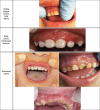The Effectiveness of E-Learning Anticipatory Guidance on Early Childhood Caries among the Mothers of Children Aged 9-24 Months during the Pandemic: A Nonrandomized Controlled Trial
- PMID: 39867118
- PMCID: PMC11760400
- DOI: 10.5005/jp-journals-10005-3009
The Effectiveness of E-Learning Anticipatory Guidance on Early Childhood Caries among the Mothers of Children Aged 9-24 Months during the Pandemic: A Nonrandomized Controlled Trial
Abstract
Background: Early childhood caries (ECC) is a multifactorial disease with known etiologic factors and can be very devastating to the oral and general well-being of a child, including psychological impacts on a growing child. Young children constitute a vulnerable population because of their dependence and inability to communicate their needs. Oral health disparities continue to pose critical challenges, as ECC is the most common chronic disease of childhood. Irony lies in the fact that milk, which is a wholesome nutrition, if fed in the wrong pattern, can be the main factor that helps this type of rampant caries spread rapidly, leading to pulp exposures and complicating proceedings. Awareness is the mainstay in prevention, and creating it becomes our sole responsibility as pediatric dentists. A multidisciplinary approach, with the involvement of mothers as the main stakeholders in this effort, becomes a very promising move. Thus, this project is phase two of an interprofessional collaboration involving mothers in prevention.
Aim: The aim of the study is to create awareness among mothers and prevent ECC during the coronavirus disease (COVID-19) pandemic.
Materials and methods: A total of 200 mothers with children aged 9-24 months were selected and added to the e-groups. The allocated mothers were given a pretest questionnaire, which was collected along with a photo of their child's oral health. Anticipatory guidance was provided to them. Follow-up was done at 2, 4, and 6 months. Awareness was evaluated by pre- and posttest questionnaires. Reversal of white spots was evaluated through indices, and progression was noted.
Statistical analysis: The data was analyzed using Statistical Package for the Social Sciences (SPSS) 13.
Results: Pretest and posttest questionnaire analysis was done using the Chi-squared test. The test showed a marked increase in the knowledge, attitude, and practice of mothers regarding their children after the postintervention, which was given through traditional anticipatory guidance.
Conclusion: In summary, the traditional anticipatory guidance intervention appeared to improve maternal knowledge but had no effect on oral health behaviors or the progression of ECC.
How to cite this article: Sathyaprasad S, Ilyas I, A A. The Effectiveness of E-Learning Anticipatory Guidance on Early Childhood Caries among the Mothers of Children Aged 9-24 Months during the Pandemic: A Nonrandomized Controlled Trial. Int J Clin Pediatr Dent 2024;17(12):1409-1417.
Keywords: Anticipatory guidance; Early childhood caries; Lift the lip; Streptococcus mutans; White spot lesions.
Copyright © 2024; The Author(s).
Conflict of interest statement
Source of support: Nil Conflict of interest: NoneConflict of interest: None
Figures






Similar articles
-
Anticipatory Guidance through Online Motivational Interviewing for Mothers on Early Childhood Caries among Young Children of Age 9-24 Months amidst Pandemics: A Nonrandomized Clinical Trial.Int J Clin Pediatr Dent. 2023 Mar-Apr;16(2):227-236. doi: 10.5005/jp-journals-10005-2567. Int J Clin Pediatr Dent. 2023. PMID: 37519978 Free PMC article.
-
Knowledge and Attitude about Early Childhood Caries among Pregnant Mothers from Low Socioeconomic Status: A Questionnaire Study.J Pharm Bioallied Sci. 2017 Nov;9(Suppl 1):S85-S87. doi: 10.4103/jpbs.JPBS_76_17. J Pharm Bioallied Sci. 2017. PMID: 29284942 Free PMC article.
-
Knowledge, Attitude, and Practice of Mothers towards Infant Oral Healthcare.Int J Clin Pediatr Dent. 2018 Sep-Oct;11(5):435-439. doi: 10.5005/jp-journals-10005-1553. Epub 2018 Oct 1. Int J Clin Pediatr Dent. 2018. PMID: 30787559 Free PMC article.
-
Interventions with pregnant women, new mothers and other primary caregivers for preventing early childhood caries.Cochrane Database Syst Rev. 2019 Nov 20;2019(11):CD012155. doi: 10.1002/14651858.CD012155.pub2. Cochrane Database Syst Rev. 2019. Update in: Cochrane Database Syst Rev. 2024 May 16;5:CD012155. doi: 10.1002/14651858.CD012155.pub3. PMID: 31745970 Free PMC article. Updated.
-
Effect of Comprehensive Dental Rehabilitation on Growth Parameters in Pediatric Patients with Severe Early Childhood Caries.Int J Clin Pediatr Dent. 2016 Jan-Mar;9(1):15-20. doi: 10.5005/jp-journals-10005-1326. Epub 2016 Apr 22. Int J Clin Pediatr Dent. 2016. PMID: 27274149 Free PMC article. Review.
References
-
- Ganesh A, Muthu MS, Mohan A, et al. Prevalence of early childhood caries in India—a systematic review. Indian J Pediatr. 2018;86:276–286. - PubMed
-
- Neves AB, Lobo LA, Pinto KC, et al. Comparison between clinical aspects and salivary microbial profile of children with and without early childhood caries: a preliminary study. J Clin Pediatr Dent. 2015;39:209–214. - PubMed
-
- Rathod SB, Nimbal AV, Khanagoudra S, et al. Early childhood caries and its prevalence among the preschool children's attending the Anganwadi's at Ukkali Vijayapura District, Karnataka India. Indian J Public Health Res Dev. 2020;11(1)
-
- Radford C, Marshall J, Herbert A, et al. Risk feeding: an Australian pediatric palliative care perspective. Perspect ASHA Spec Interest Groups. 2020;5(2):515–521.
LinkOut - more resources
Full Text Sources
